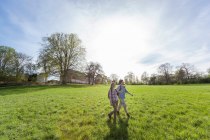Osthofener Leckzapfen (Licking tap of Osthofen)
Pour me another tasty little glass of wine, dear cellar master!
Tasty or licking or both? And which tap? The tap or a tapping? The site is named after the miniature castle "Leckzapfen", built in 1891 by the Osthofen-based estate and mill owner Gustav Friedrich Weißheimer. The brick-and-clinker castle with a round tower on the side is a real gem - and bears a resemblance to the famous fairytale castle of Lichtenstein. After years of decay, it was lovingly renovated and in 2011 was named the "Most Beautiful Vineyard Cottage in Rheinhessen". On fertile loess grow Riesling, Silvaner and burgundy varieties. Legend has it that the wines were already so good in the Middle Ages that the cellar master would lick the spigot of the wine cask to get hold of the last drop.
> The castle was first called "Gustavsburg" after its builder, later it was called "Leckzapfen". All information about the landmark and its rescue by a young architect and other active people: https://kulturnetzwerk-osthofen.de/2018/01/10/rettung-des-leckzapfen/.
> The builder was the brother of the Rheinhessen composer Wendelin Weißheimer: https://www.osthofen.de/leben-in-osthofen/stadtportrait/wichtige-persoenlichkeiten
> Hike (2.5 h / 8.3 km) to the miniature castles: https://www.osthofen.de/osthofen-erleben/aktiv-natur/wandern/miniaturburgen-im-wonnegau
> The miniature castle is owned by the Kratz Winery, Schönauer Hof. Events and wine tastings are held there. The small "hall" on the upper floor with floral-ornamental decorated wooden ceiling offers a wonderful panorama. https://www.weingut-kratz.de/
> Cf. the namesake Dittelsheimer Leckerberg













